The raw data is at the state level and I would like to go down to the county level. To do this, I first adjusted the data to county level and then interpolated it.
The raw data on state level looks like this: object name "df.sf"
Simple feature collection with 16 features and 5 fields
Geometry type: MULTIPOLYGON
Dimension: XY
Bounding box: xmin: 848097.3 ymin: 2281812 xmax: 1485685 ymax: 3136914
Projected CRS: NTF (Paris) / Lambert zone II + NGF Lallemand height
First 10 features:
CC_1 cty_area psych_dis dpr BMI
1 8 36095215398 19.07783 12.00708 26.07741
2 9 70643514694 19.79458 12.37472 25.63492
3 11 900908400 20.43846 12.49231 25.13092
4 12 29954144448 20.20175 12.37719 26.61934
5 4 404969822 18.00000 11.33333 25.32944
6 2 747005892 18.23529 11.80392 24.56922
7 6 21203879353 19.52273 12.06364 25.83914
8 13 23736584551 21.46269 13.32836 26.73993
9 3 48207855936 20.56610 12.80000 25.68827
10 5 34345207798 19.95376 12.45279 26.12742
geometry
1 MULTIPOLYGON (((1077800 231...
2 MULTIPOLYGON (((1156417 230...
3 MULTIPOLYGON (((1338714 287...
4 MULTIPOLYGON (((1279750 284...
5 MULTIPOLYGON (((1029656 291...
6 MULTIPOLYGON (((1125077 297...
7 MULTIPOLYGON (((1058410 253...
8 MULTIPOLYGON (((1203756 304...
9 MULTIPOLYGON (((894800.9 29...
10 MULTIPOLYGON (((1004934 264...
The raw data adjusted at the county level is as follows: object name "bl.lk"
Simple feature collection with 401 features and 4 fields
Geometry type: MULTIPOLYGON
Dimension: XY
Bounding box: xmin: 848080 ymin: 2281823 xmax: 1485607 ymax: 3136923
Projected CRS: NTF (Paris) / Lambert zone II + NGF Lallemand height
First 10 features:
AGS BMI dpr psych_dis geometry
1 1001 26.68627 11.61818 19.20000 MULTIPOLYGON (((1064024 311...
2 1002 26.68627 11.61818 19.20000 MULTIPOLYGON (((1111437 307...
3 1003 26.68662 11.62940 19.21484 MULTIPOLYGON (((1161867 303...
4 1004 26.68627 11.61818 19.20000 MULTIPOLYGON (((1102924 304...
5 1051 26.68627 11.61818 19.20000 MULTIPOLYGON (((1058696 302...
6 1053 26.68471 11.62609 19.20966 MULTIPOLYGON (((1165074 298...
7 1054 26.68627 11.61818 19.20000 MULTIPOLYGON (((1003984 308...
8 1055 26.68627 11.61818 19.20000 MULTIPOLYGON (((1149981 305...
9 1056 26.67913 11.61881 19.19674 MULTIPOLYGON (((1102964 298...
10 1057 26.68627 11.61818 19.20000 MULTIPOLYGON (((1130439 307...
This is the plot of both:
After this, I made a grid of 10x10 km and adjusted it to the borders of Germany:
EDIT: HOW I MADE THE GRID
### I made first an sf object with just the borders of Germany
ger <- map %>%
summarize()
### I made the 10 x 10 km² grid
grid <- sf::st_make_grid(ger, cellsize = c(10*1000,10*1000))[ger]
### turning back to an sf object
grid<-sf::st_sf(grid)
### adapt to the borders
grid<-sf::st_intersection(grid,ger)
object name "grid"
Simple feature collection with 3885 features and 0 fields
Geometry type: GEOMETRY
Dimension: XY
Bounding box: xmin: 848097.3 ymin: 2281812 xmax: 1485685 ymax: 3136914
Projected CRS: NTF (Paris) / Lambert zone II + NGF Lallemand height
First 10 features:
grid
1 POLYGON ((1186108 2291812, ...
2 POLYGON ((1198097 2291812, ...
3 POLYGON ((1198097 2291812, ...
4 POLYGON ((998097.3 2301812,...
5 MULTIPOLYGON (((1008097 230...
6 MULTIPOLYGON (((1014797 230...
7 POLYGON ((1028097 2301812, ...
8 POLYGON ((1028097 2301812, ...
9 MULTIPOLYGON (((1185004 229...
10 POLYGON ((1188097 2301812, ...
grid plot:
After fitting my variogram model using a spherical model, I interpolated my data on the new grid. Therefore I used the package "gstat".
This is my variogram plot:
EDIT PART 2: HOW I MADE "dpr.krg"
dpr.krg<-gstat::krige(dpr~1,blk.sp,
newdata = grid, model=fv.dpr)
### the object "blk.sp" is the spatial object of bl.lk
blk.sp<-as_Spatial(bl.lk)
I used the ordinary kriging method to interpolate my data: object name: "dpr.krg"
Simple feature collection with 3885 features and 4 fields
Geometry type: MULTIPOLYGON
Dimension: XY
Bounding box: xmin: 848097.3 ymin: 2281812 xmax: 1485685 ymax: 3136914
Projected CRS: NTF (Paris) / Lambert zone II + NGF Lallemand height
First 10 features:
x y var1.pred var1.var geometry
1 1185538.0 2291408 12.38589 0.03540585 MULTIPOLYGON (((1186108 229...
2 1195629.5 2286807 12.40707 0.03757786 MULTIPOLYGON (((1198097 229...
3 1201101.8 2288814 12.41246 0.03702310 MULTIPOLYGON (((1198097 229...
4 996635.3 2300961 12.14110 0.03187281 MULTIPOLYGON (((998097.3 23...
5 1004070.0 2298689 12.13117 0.02802191 MULTIPOLYGON (((1008097 230...
6 1009703.8 2300029 12.11553 0.02637842 MULTIPOLYGON (((1014797 230...
7 1023116.7 2300258 12.10389 0.02533177 MULTIPOLYGON (((1028097 230...
8 1030446.8 2300867 12.09814 0.02590088 MULTIPOLYGON (((1028097 230...
9 1186016.8 2297043 12.38064 0.02771807 MULTIPOLYGON (((1185004 229...
10 1193204.4 2297477 12.39328 0.02687693 MULTIPOLYGON (((1188097 230...
I guess it looks pretty good:
FROM HERE MY QUESTION BEGINS!
I wanted now to aggregate the interpolated data back to couty level using the means of the "nearest feature" or the means of the "intersections", I'm not really sure.
I have tried two approaches with different results.
First I tried this attempt:
a1<-st_join(bl.lk,dpr.krg,left=T) %>%
aggregate(list(.$var1.pred), mean)
a1
Simple feature collection with 3878 features and 9 fields
Attribute-geometry relationship: 0 constant, 8 aggregate, 1 identity
Geometry type: GEOMETRY
Dimension: XY
Bounding box: xmin: 848080 ymin: 2281823 xmax: 1485607 ymax: 3136923
Projected CRS: NTF (Paris) / Lambert zone II + NGF Lallemand height
First 10 features:
Group.1 AGS BMI dpr psych_dis x y var1.pred
1 11.48022 10042.50 26.21000 11.44444 17.92593 923097.3 2486812 11.48022
2 11.48889 10044.00 26.21000 11.44444 17.92593 917522.5 2479905 11.48889
3 11.49469 10042.50 26.21000 11.44444 17.92593 933097.3 2486812 11.49469
4 11.49718 10042.50 26.21000 11.44444 17.92593 923568.2 2477160 11.49718
5 11.50216 10044.00 26.21000 11.44444 17.92593 914425.8 2488008 11.50216
6 11.51038 10041.00 26.21000 11.44444 17.92593 933200.6 2479981 11.51038
7 11.52432 10043.00 26.21175 11.44758 17.93198 923097.3 2496812 11.52432
8 11.53093 10041.00 26.21000 11.44444 17.92593 927361.3 2471509 11.53093
9 11.53557 10041.00 26.21000 11.44444 17.92593 928485.0 2471459 11.53557
10 11.53784 10042.67 26.21042 11.44521 17.92740 933097.3 2496812 11.53784
var1.var geometry
1 0.011184110 POLYGON ((929972.4 2474426,...
2 0.021920620 POLYGON ((933251.2 2507013,...
3 0.008358825 POLYGON ((929972.4 2474426,...
4 0.017955294 POLYGON ((929972.4 2474426,...
5 0.016334040 POLYGON ((933251.2 2507013,...
6 0.011367280 POLYGON ((928068.5 2477750,...
7 0.008089616 POLYGON ((935840.3 2508670,...
8 0.023942613 POLYGON ((928068.5 2477750,...
9 0.023667212 POLYGON ((928068.5 2477750,...
10 0.009007377 POLYGON ((929972.4 2474426,...
And my second approach was:
a2<-st_join(bl.lk,dpr.krg, left=T) %>%
group_by(AGS) %>%
summarise(mean(var1.pred))
names(a2)[names(a2) == "mean(var1.pred)"] <- "var1.pred"
a2
Simple feature collection with 401 features and 2 fields
Geometry type: MULTIPOLYGON
Dimension: XY
Bounding box: xmin: 848080 ymin: 2281823 xmax: 1485607 ymax: 3136923
Projected CRS: NTF (Paris) / Lambert zone II + NGF Lallemand height
# A tibble: 401 x 3
AGS var1.pred geometry
<int> <dbl> <MULTIPOLYGON [m]>
1 1001 11.7 (((1064024 3116513, 1064892 3115261, 1065097 3113239, 1065~
2 1002 11.6 (((1111437 3076630, 1112124 3077127, 1113655 3074885, 1114~
3 1003 11.9 (((1161867 3031796, 1161406 3032579, 1163017 3032765, 1164~
4 1004 11.6 (((1102924 3044050, 1103845 3044400, 1105259 3043551, 1106~
5 1051 11.8 (((1058696 3028055, 1058403 3027541, 1059516 3026845, 1059~
6 1053 12.1 (((1165074 2985679, 1166003 2982501, 1165265 2981093, 1165~
7 1054 11.8 (((1003984 3083561, 1005616 3084030, 1006873 3081947, 1005~
8 1055 11.9 (((1149981 3056897, 1149236 3056726, 1149037 3058245, 1150~
9 1056 11.9 (((1102964 2986154, 1102281 2984642, 1101395 2983211, 1100~
10 1057 11.6 (((1130439 3075640, 1133078 3074357, 1136994 3073664, 1140~
# ... with 391 more rows
I'm just intrested for the "var1.pred".
If I plot now both I realised, that I get two different plots and values. So, I'm not sure,if I used the correct approaches. I thought also about using "st_intersect" or "st_nearest_feature" but I'm not sure how to implement those commands into the script.
The plots of a1 and a2:
Also, I'm sure if I'm allowed to this. I did not found any papers, about making regresions, with interpolated data.
I used the following packages: sf, gstat, tidyverse, automap
